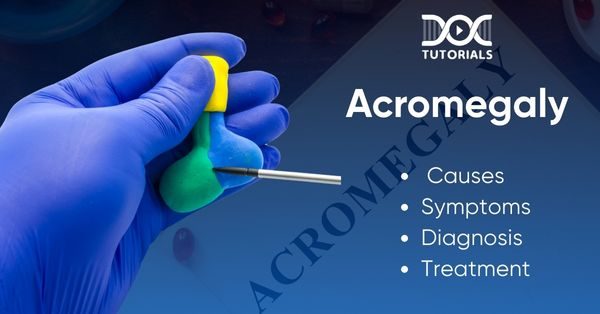Acromegaly: Causes, Symptoms, Diagnosis, and Treatment

Acromegaly is a rare yet serious medical condition resulting from excessive growth hormone production in the body. This hormonal imbalance leads to abnormal growth of bones and tissues, causing irregular changes in physical features. Being a NEET aspirant requires a detailed understanding of such complex conditions to establish strong fundamental medical knowledge and skills.
Let us dive deeper into this guide to learn the causes, symptoms, and treatment approaches associated with acromegaly.
What is Acromegaly?
The overproduction of growth hormone by the pituitary gland during adulthood becomes the basis for developing acromegaly. An imbalance of hormones produces abnormal bone development that primarily affects the hands, along with the feet and the face, but does not increase total height.
This is different from gigantism, which causes increased height in children. Since acromegaly is a rare disorder, and the physical changes develop gradually over a number of years, this often results in a delayed diagnosis.
Untreated, excess growth hormone can affect the bones as well as other parts of the body.
What are the Causes of Acromegaly?
The most common cause of increased GH production in adults is the presence of a tumour.
- Pituitary Tumours
Acromegaly is caused by the presence of a tumour in the pituitary gland, known as a pituitary adenoma, which leads to the excessive release of growth hormone (GH). Growth of pituitary adenomas is progressive and mostly benign.
Thus, the occurrence of elevated GH levels may take quite a time before patients manifest such symptoms. The size and location of the adenoma can influence how it impacts surrounding pituitary tissue, potentially affecting the production of other hormones.
If the tumour grows significantly, it may also exert pressure on nearby areas of the brain, leading to symptoms like headaches and vision disturbances.
- Non-Pituitary Tumours
In rare cases, acromegaly may develop due to tumours located in organs other than the pituitary gland, such as the pancreas or lungs. They might directly produce growth hormone or release a hormone called growth hormone-releasing hormone (GH-RH), which signals the pituitary gland to increase GH production.
What are the Symptoms of Acromegaly?
Acromegaly symptoms often develop gradually, making them challenging to identify at first. In many cases, changes may only become apparent when rings no longer fit comfortably or when shoe sizes increase unexpectedly.
Recognising the following symptoms may indicate the presence of acromegaly:
- Enlargement of Hands and Feet: Hands and feet may grow out of proportion from the body.
- Thickening of Facial Features: The jaw, nose, and lips will appear larger or more pronounced.
- Frequent Headaches: Frequent headaches might occur due to the pressure of the tumour.
- Oily Skin and Increased Sweating: Glands may secrete more oils and sweat as they tend to become larger and denser.
- Fatigue and Depression: Unusual tiredness and depressive states can be caused by physiologic and hormonal shifts associated with acromegaly.
- Heart Disease and Enlargement of the Heart: Prolonged increased levels of GH and Insulin-like Growth Factor 1 (IGF-1) might contribute to heart diseases.
- Loss of Vision: Involves the transgression of the tumour from painful pressure against neighbouring nerves.
- Hypertension: Elevated blood pressure can pose a potential sign of acromegaly.
- Symptoms of Diabetes: Sudden onset of diabetes could also be indicative.
- Impotence and Decreased Libido: A rise in hormone levels generally causes a problem with sexual functions.
- Irregular Periods of Menstruation: These disturbances may be due to fluctuations in hormone levels.
- Obstructive sleep apnea: Individuals may notice symptoms of obstructive sleep apnea.
- Arthritis or Carpal Tunnel Syndrome: Pain in joints and loss of motion may develop.
- Chronic Headaches and Increasing Joint Pain: Persistent headaches and worsening joint discomfort can indicate advanced acromegaly.
How is Acromegaly Diagnosed?
People have difficulty detecting acromegaly disease because the symptoms develop slowly over time. A majority of individuals stay ignorant about their condition until major symptoms appear. Most develop symptomatic acromegaly disease during middle age, yet the condition can appear at any stage of life.
- Blood Tests
Blood tests are commonly used to detect elevated growth hormone (GH) levels, but since GH levels naturally fluctuate throughout the day, these tests may not always be accurate. To obtain more reliable results, healthcare providers often recommend a glucose tolerance test. During this test, the individual consumes 75 to 100 grams of glucose, followed by the measurement of GH levels. In individuals without acromegaly, the presence of excess glucose suppresses GH levels. However, in those with acromegaly, GH levels remain elevated despite glucose intake.
- Insulin-Like Growth Factor 1 (IGF-1)
The diagnosis of acromegaly can be facilitated through testing insulin-like growth factor 1 (IGF-1). Generally, the body exhibits excessive growth when IGF-1 shows abnormal levels in blood tests. IGF-1 testing provides healthcare providers with an effective method to evaluate the success rate of hormone medications.
- Imaging Studies
Medical professionals conduct X-ray and Magnetic Resonance Imaging (MRI) examinations to investigate the possibility of bone overgrowth among their patients. They also perform physical assessments supported by sonograms to assess dimensional changes in internal organs.
What are the Complications of Acromegaly?
Acromegaly can lead to serious and potentially life-threatening complications, including:
- Hypopituitarism (reduced pituitary hormone production)
- Cardiomyopathy (heart disease)
- Colon polyps (precancerous growths)
- Hypertension (high blood pressure)
- Spinal cord compression
- Diabetes
- Vision loss
- Uterine fibroids
- Arthritis
- Carpal tunnel syndrome
- Kidney failure
- Sleep apnoea
What are the Treatment Options for Acromegaly?
Acromegaly treatment varies on the basis of individual factors like the location and size of the tumour, symptom severity, age, and overall health. Usually, acromegaly treatment aims to reduce GH and IGF-1 levels through surgery, radiation, or medication.
- Surgery
Doctors commonly conduct transsphenoidal surgery to extract the majority of pituitary tumours. The surgical route to reach the pituitary gland goes through the nostrils of the patient. Surgery requires another procedure when the tumour position is not inside the sphenoid bone.
The removal of tumours results in normal GH production. Total pressure reduction on tissue surroundings provides relief from headaches as well as vision disturbances. The complete removal of pituitary tumours remains challenging due to certain instances where excessive GH levels continue.
Other treatments, including additional surgery, medication, or radiation therapy, will be necessary for these cases.
- Medications
Medication may be prescribed to restore hormone levels to normal. Options include:
- Growth Hormone Antagonists: Pegvisomant (Somavert) blocks GH from affecting bodily tissues. It is administered as a daily injection and can effectively lower IGF-1 levels, even if GH levels or tumour size remain unchanged. This treatment is particularly beneficial for individuals who have not responded well to conventional therapies.
- Somatostatin Analogues: These drugs reduce the production of growth hormone.
- Radiation
Radiation therapy may be recommended if the tumour cannot be entirely removed through surgery. This approach gradually lowers GH levels and eradicates any remaining tumour cells. However, the effects of radiation therapy may take several years to become apparent.
Radiation therapy can also reduce levels of other pituitary hormones, requiring lifelong monitoring and regular follow-ups.
Forms of radiation therapy include:
- Conventional Radiation Therapy: Typically administered daily over four to six weeks. Full effects may take a decade or longer to manifest.
- Stereotactic Radiosurgery: This technique utilises 3D imaging to deliver targeted, high-dose radiation to tumour cells while minimising exposure to surrounding tissues. Usually delivered in a single dose, this method may normalise GH levels within five to ten years.
FAQs About Acromegaly
- What are the common symptoms of acromegaly?
Symptoms of acromegaly include enlarged hands and feet, thickened facial features, persistent headaches, vision disturbances, oily skin, excessive sweating, fatigue, joint pain, and, in some cases, heart disease or diabetes.
- Can acromegaly be treated with surgery?
Yes, acromegaly can be treated with surgery by removing the pituitary tumour to reduce excessive growth hormone production.
- What medications are used to treat acromegaly?
Medications for acromegaly include growth hormone antagonists (like Pegvisomant), somatostatin analogues (to reduce GH production), and dopamine agonists (to shrink tumours and decrease GH levels).
- What are the potential complications of untreated acromegaly?
If left untreated, acromegaly can cause complications such as cardiomyopathy, hypertension, diabetes, sleep apnea, vision loss, arthritis, and an increased risk of colorectal polyps and cancer.
- Can acromegaly occur in children?
When acromegaly occurs in children, it results in a condition known as gigantism, which leads to excessive height and abnormal bone growth. In adults, it does not affect height but causes enlargement of bones and tissues.
Conclusion
Acromegaly is a rare but serious hormonal disorder caused by excessive growth hormone production, usually due to pituitary adenomas. Early diagnosis and timely intervention are crucial to managing symptoms and preventing complications. Moreover, treatment approaches like surgery, medication, and radiation therapy aim to normalise hormone levels and improve quality of life.
DocTutorials is your ultimate companion in mastering such medical concepts for NEET PG 2025. Our comprehensive video lectures, expert guidance, and thoughtfully designed mock tests equip you with the skills to build a strong foundation and sharpen your diagnostic abilities. With a strategic approach, we help you boost your performance and gain the confidence needed to excel in your exam. Start your NEET PG journey today and move a step closer to fulfilling your medical career!
Latest Blogs
-

NEET PG Exam 2025- Date, Pattern, Marking Scheme, Subject Wise Weightage, and Exam Mode
NEET PG Exam 2025 is the ultimate gateway for medical graduates aspiring to pursue postgraduate courses in medicine, including MD,…
-

INI CET Exam 2025: Your Roadmap to Success – Key Topics, Strategies, and Lessons from Last Year’s Papers
The INI CET exam is more than just a test; it’s a significant milestone for many medical students aiming to…
-

INI CET Exam Success: Previous Year Question Papers & Ultimate Guide – INI CET PYQ
One can feel overwhelmed while preparing for the INI CET (Institute of National Importance Combined Entrance Test). A vast syllabus,…




